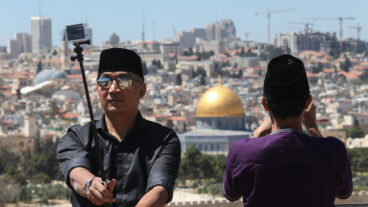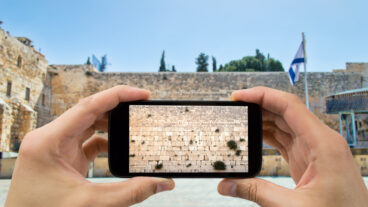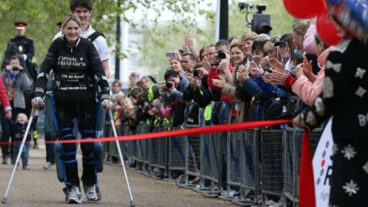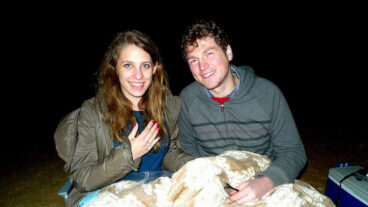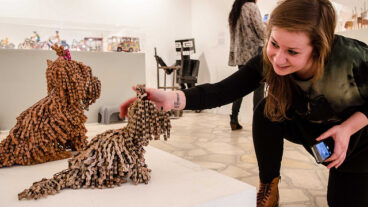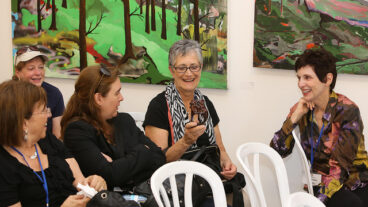Building a foundation of trust through working
together.At the end of June, Jewish students from the Menashe Regional Council joined Arab students from Kfar Kara and Barta’a on a trip to the shores of the Kinneret [Sea of Galilee]. The 30 Israeli student volunteers are in the first year of a three-year coexistence program run through their schools, with the goal of learning coexistence through community service.
This particular trip to the Kinneret was part of an ongoing project of the Society for the Protection of Nature in Israel (SPNI) that aims to help save the public beaches around Israel’s only lake from neglect, as well as preventing owners of private beaches from having a monopoly over the Kinneret’s shoreline. As an intern at Givat Haviva, the Jewish-Arab Center for Peace, I was fortunate enough to be able to tag along on the camping trip and work with the kids as a counselor.
According to a representative of the SPNI, “private ownership of beaches around the Kinneret prevents many families from being able to enjoy a day at the beach, as the private beach owners charge exorbitant prices (approximately NIS 80 – or $18 – per car) to use their facilities”. The SPNI wants to reclaim the Kinneret as public land for all Israelis to enjoy freely, and the staff hopes that the work they do with teenagers will help bring attention to their cause. The teens on this trip were helping to clear a path along the Kinneret that would eventually become a pedestrian walkway around the lake.
Essentially, the aim of the project was two-fold: saving the Kinneret was the direct aim of the 5-day camping trip, which was organized with the help of Givat Haviva, an educational seminary, and coordinated and led by representatives from the SPNI. I spoke with Elad, a teacher in the Menashe Region and chaperone on the Kinneret trip, about the role of community work in the coexistence project. He told me of the necessity to build a foundation of trust through working
together. “We want the kids to learn that working together is possible. This is the basis of their entire three years together: coexistence in action.”
I wanted to know what the kids thought about the task ahead of them, so I approached Laila Kabaha, 15, an Israeli Arab from the town of Barta’a and asked why she decided to join this project. Before I even finish my question Laila bursts out: “Living with the Jews. This is the most important thing.” Her face was very serious; she looked at me intensely in as we walked together along the path. “It is very important to me that this [work] shows that the Jewish [people] are not bad people. That we can work together.”
Laila took me to the area where the students were working, and there I found a truly astonishing sight: through the thick wall of bamboo a trail had been hacked, snipped and power-sawed into existence. We scrambled down the bamboo- and bush-covered incline to the path below, and I found that I was overwhelmed with respect for these 15 and 16-year-olds who volunteered their time to this project. The work needed in order to clear the path around the Kinneret was obviously strenuous, hot, dirty and certainly daunting. Around me Laila and several of the boys hacked away at the limbs of a large tree that had spread itself every which-way along the shoreline. To
the right of us, through the trees and thick bamboo, we could hear Nissim’s rallying cry to the kids, “We’ll meet! We’ll meet in the middle!” Just 15 minutes later Nissim and his team of workers broke through to our side and one by one the students climbed through to the little clearing. Sweaty and a little grumpy from lack of sleep, the kids continued north along the newly-forged path back towards the camp, still hacking and chopping away with fierce determination.
Despite the hard work, early hours and unbearable heat, I never heard any of the kids complain about the work. Any parent who struggles each day to get their kids out of bed in the morning would have been shocked at the sight of these teenage volunteers, rolling out of bed at 5:30 a.m. and then, heavy-duty tools in hand, trudging off to work by 6:00. This was certainly a unique and admirable group of kids. What was even more admirable was that the students were working side by side with “the other” – the people they had been told to fear, mistrust and even hate.
Sanaa Kabaha of Barta’a told me that the only Jews she had ever spoken to before were the cashiers in stores. Of the Jewish students kids, only one had ever had contact with an Arab Israeli before. Despite the barriers that had prevented them from knowing each other the students from the both groups were unanimous in their belief that they could work together.
These were not simple words or half-hearted promises; working in mixed teams of Arabs and Jews the students managed to clear over 65 feet of dense vegetation in just one morning, allowing for over 1300 feet of trail to be connected. The next day the students cleared over half a mile of bush to Ha-On beach, making a smooth and much more accessible path along the lake. Each day’s work was a small triumph; the Kinneret was being returned to the Israeli people from the hands of private owners and the students were learning how all of Israel’s citizens could work together to make Israel a greater country.
At the same time, it was easy to see that coexistence would not happen overnight. The students for the most part stuck to their own groups and there was little socializing between them. Despite good intentions, the barriers of language, culture and trust issues were still there for them to overcome.
In order to help the students break the ice we decided that a dialogue session might be in order. Leo Williams, an intern at Givat Haviva, helped organize an evening of discussion around the topic of coexistence. “Coexistence doesn’t mean that we all have to live together and be together,” says Guy Farjon of Menashe.
“Coexistence means we have to have respect and
understanding for one another.” What was clear from the students was that the situation as it stands between Arabs and Jews in Israel was certainly not coexistence. As many put it bluntly “There is a wall between us [Arabs and Jews in Israel].”
Hopefully, projects like the Kinneret trip will help break that wall.
In the three years the students will spend together they will have to tackle subjects that will inspire anger, fear and sadness, even hatred and love.
The goal of the Kinneret program is to give students of different religions, cultures and languages the knowledge that no matter what, they can work together for peace.




